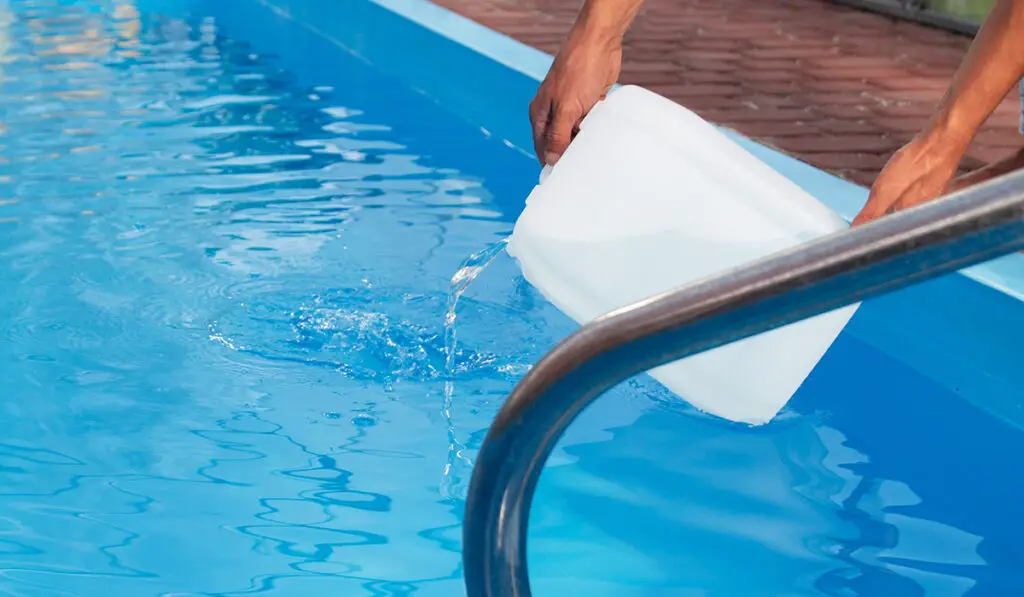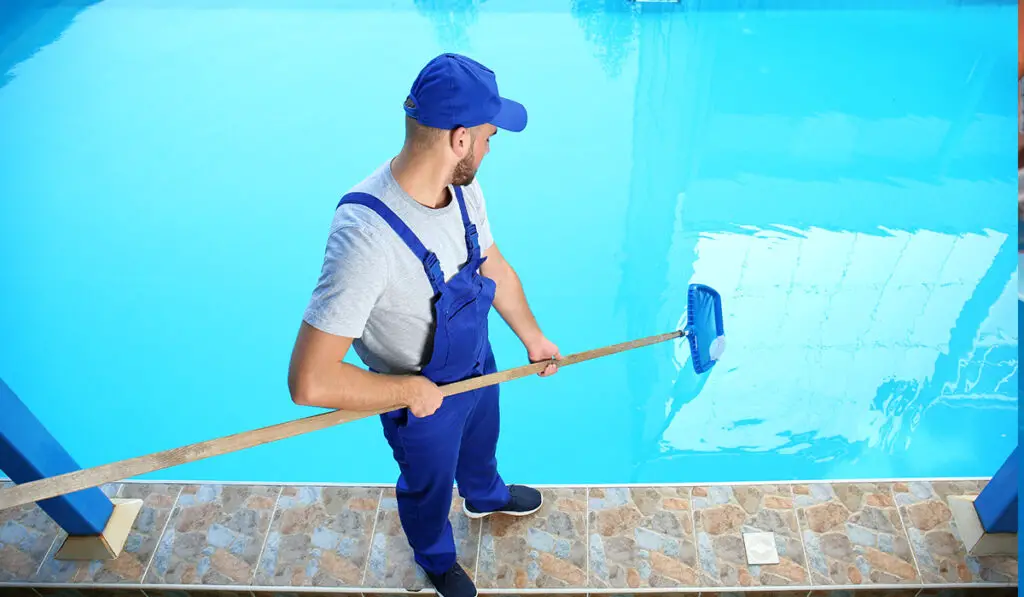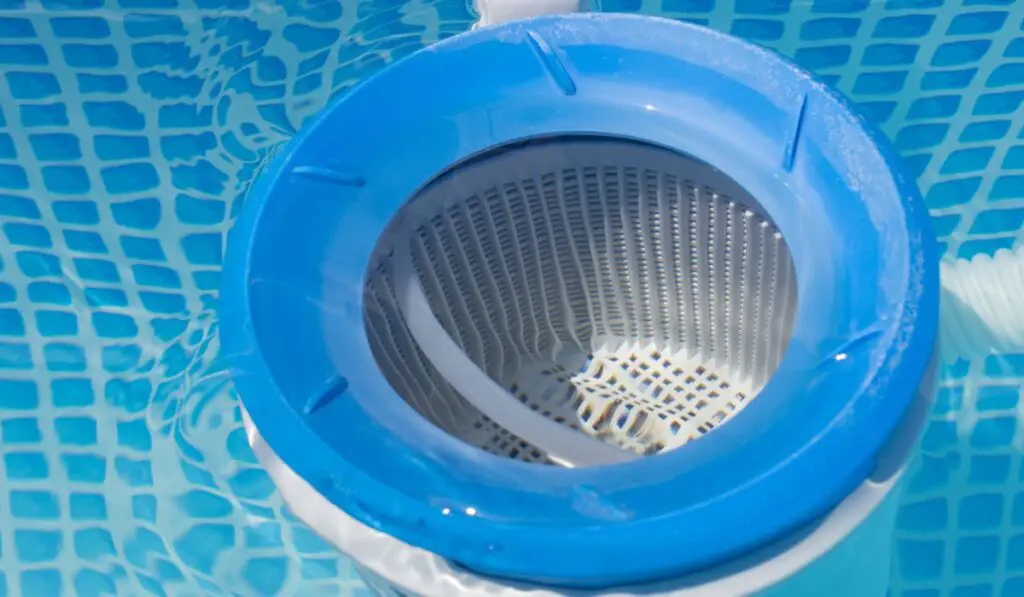Sometimes, your pool’s filtration system won’t suffice to keep the water clean. So, if your pool looks cloudy, it might be time to use a chemical commonly known as pool flocculant.
Pool flocculant — or pool floc — is a chemical you can add to your pool to clear it of germs and bacteria. It works by clumping small, light particles together so that they can be removed more easily. However, pool floc doesn’t kill algae, so be sure to remove algae with an algaecide ahead of time.
If you’re looking to maintain a clean pool, using a pool flocculant is one of the best steps you can take. Let’s take a look at everything you need to know before using pool floc, including its benefits and downsides and how to use it properly.
What Is Pool Flocculant?

Pool flocculant, often shortened to just “pool floc,” is a safe chemical that you can add to your pool to efficiently clear the water of germs and bad bacteria. Using a pool flocculant is often the last resort when other cleaning measures are not working.
Flocculants work by clumping microscopic floating particles together. These particles are usually too small and light to sink to the bottom of the pool themselves, and the pool’s filtration system might not pick them up as a result. Instead, they tend to remain in the water until you use a flocculant like this one from Clorox (on Amazon).
Adding pool flocculant to the water helps clump the smaller and lighter particles together. They then become weighty enough to sink to the bottom, making it easier for yourself or the filtration system to vacuum them up.
Pool Floc vs. Pool Clarifier: Which Is Better?
Pool clarifiers are more popular than flocculants because clarifiers are milder. Both options are coagulants, but clarifiers are less harsh if they remain in the water after completing their job.
Unlike a pool clarifier, flocculants work immediately. Clarifiers — like this one (on Amazon) — may take a few days to work because the chemical creates smaller clumps. Due to the slower process, it might make you wonder why anyone would choose a clarifier over a pool floc.
One isn’t necessarily better than the other; the key difference is efficiency. Pool flocculants work quickly, offering fast and efficient results so you can enjoy clean pool water almost immediately.
What Are the Benefits of Pool Floc?
Now that you know about the efficiency of pool flocculants, you might be wondering about their other benefits. After all, there are several reasons why it’s such a popular and highly-rated product for cleaning pool water. Here’s more on the benefits of pool floc:
It Works Quickly
Pool flocculant works as soon as it’s added to the pool water. You won’t need to wait for the process to begin. The task will be completed within a few hours so that you can enjoy a clean and bacteria-free pool as soon as possible.
Highly Effective
It’s rare to see bacteria and virus particles left behind when the pool flocculant has finished its process. The product is highly effective at clumping together and removing bad bacteria from pool water.
It Works With Various Types of Filters
Pool flocculants can work with various pool filtration systems, including sand filters and diatomaceous earth (DE). That means most pool owners can use pool floc without issue.
What Are the Downsides?

Like any chemical product, pool flocculant does have its downsides, which are as follow:
It Doesn’t Kill Algae
Pool flocculants can have trouble killing algae. Pool algae typically form clusters on pool steps, toys, and other harder surfaces. Algae are small and lightweight, so they usually won’t float to the bottom or toward the filtration system.
Hence, you must remove the algae before using pool floc so that the chemical can kill the rest of the bad bacteria in the pool. As a result, your pool will be free of algae and bad bacteria.
Some Manual Work May Be Needed Before Using Pool Floc
In addition to removing the algae from the pool before using the pool floc, you might also need to perform some other manual work.
Sometimes, you need to skim the top of the water to remove what you can before using the pool floc. Doing so will help the chemicals work more efficiently, resulting in clearer water.
You won’t need to spend much time skimming, but it might need to be done before using the pool foc so that it can have the maximum effect.
Furthermore, pool floc sometimes fails to sink the particles if they don’t form in large enough clumps. Hence, not all bacteria will be removed, and you might be required to perform another round of chemical treatment.
It Can’t Be Used With Cartridge Filters
Although pool floc can be used with sand and DE filters, it doesn’t work well with cartridge filters.
Pool floc can only work with cartridge filters if you have a custom setup that allows for it. Therefore, it’s most beneficial to use pool floc if you have a sand or DE filter.
Can You Use Pool Floc With Algaecide?
As we mentioned earlier, it’s essential to address the algae in your pool before you use pool floc. Although pool floc is effective at breaking down and removing bacteria and germs, it isn’t as effective at removing algae.
Pool flocculant and algaecide cancel each other out. Therefore, you must remove algae before using pool floc chemicals.
To remove algae, you can use the algaecide (on Amazon). Use this before you begin the pool floc process and ensure all algae and algaecide have been removed from the water so the pool floc can have maximum effect.
How to Use Pool Flocculant
Using a pool flocculant is simple. After removing the algae from your pool, it doesn’t require much work. The following steps should be taken to ensure the pool flocculant can work efficiently.
- Increase the water level: It’s common to lose water when using pool floc. Therefore, raise the water level before you begin the process to avoid the water dropping below the filter level.
- Balance the pH level in the pool: It’s essential to ensure the pH level in your pool is balanced to help the pool floc work at maximum capacity. It’s recommended that the pH level be 7. If your pH levels are too low, read our guide for raising your pool’s pH.
- Dilute the pool floc: The pool flocculant needs to be diluted before use. It’s a strong chemical and shouldn’t be added to the water in its pure form. Therefore, read the instructions on your pool floc and be sure to follow the directions closely.
- Add the flocculant: Next, you will need to pour the diluted pool flocculant mixture into the pool. It’s best to pour it in at the sides so that it can spread and do its job.
- Run the pump: Now it’s time to run the pool pump. It’s recommended to run the pump for a few hours so the flocculant can disperse around the entire pool.
- Let it sit: Some flocculants work best when left to sit overnight. Therefore, turning off the pool pumps and letting the pool floc sit overnight can be beneficial. 8 hours is plenty of time for the flocculant to collect the waste.
- Turn on the “waste” function: Switch your filter valve to the waste setting so the filtration process can begin.
- Turn the pump back on: Now that the flocculant has had time to work and the waste function is ready, switch the pump back on. You’ll notice clumps of sediment at the bottom of the pool; these will filter out when the pumps start.
- Vacuum the pool if you need to: In most cases, vacuuming after the pump has done its job will ensure you have removed all sediment. Vacuum the bottom of the pool to collect anything left behind.
- Add new water: It’s important to add new water to your pool to maintain the proper water level.
- Clean the filters: Your pool’s filters will have a lot of leftover sediment and chemicals, so clean them thoroughly. You will experience a buildup if you forget to do this, and a buildup can hinder the next filtration process.
Why Your Pool Floc Might Not Work

In some cases, pool floc might not work properly, or you might notice leftover sediment or bacteria in your pool. Don’t panic if this happens; there are several reasons why pool floc might not do its intended job.
- Filter issues: If your filter is blocked or damaged, the pool floc won’t be efficiently removed from the pool. Clean or adjust the filter and try again. Always check that your filter is working before you add pool floc to the pool to avoid waste.
- Live algae: If there are live algae in your pool, the pool floc won’t remove it. Use an algaecide first to remove live algae so the pool floc can work effectively.
- Pool debris: Pool flocculant will only work to remove bacteria and viruses. It won’t be able to clump leaves or other debris together. Therefore, remove any debris in the pool before you use pool floc to ensure it works.
